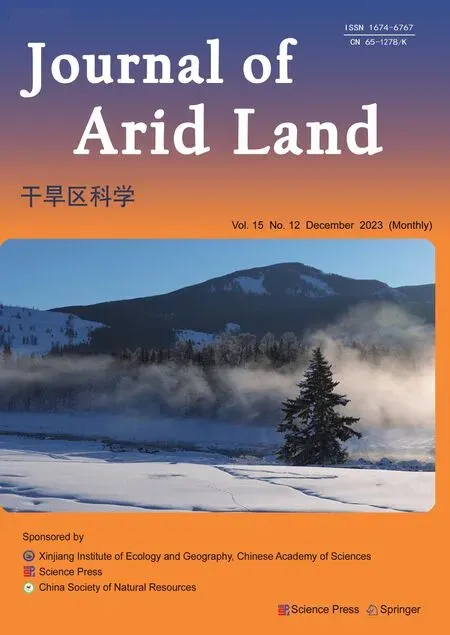Effects of degradation and species composition on soil seed density in the alpine grasslands, China
LI Chunming, MA Jiahui, LI Liangyu, HUANG Junlin, LU Jinhua, HUANG Mei,Allan DEGEN, SHANG Zhanhuan
1 Life Science and Engineering College of Northwest Minzu University, Lanzhou 730124, China;
2 State Key Laboratory of Herbage Improvement and Grassland Agro-ecosystems, College of Ecology, Lanzhou University,Lanzhou 730000, China;
3 Desert Animal Adaptations and Husbandry, Wyler Department of Dryland Agriculture, Blaustein Institutes for Desert Research,Ben-Gurion University of the Negev, Beer Sheva 8410500, Israel
Abstract: Grassland degradation can alter the structure and function of ecosystem and soil seed bank.Therefore, estimating the role of soil seed bank in vegetation regeneration of degraded grasslands is crucial.We selected grasslands with three levels of degradation, namely non-degraded (ND), mildly degraded (MD), and heavily degraded (HD) to analyze the effect of grassland degradation on soil seed bank, as well as the role of soil seed bank on vegetation regeneration of the alpine grasslands, China.Soil samples from each level were collected in May, before seedling emergence, in August, after completion of transient seed bank germination, and in December, after seed dispersal, to determine the seed density and species composition through germination experiment.Result showed that a total of 35 plant species was identified, including 15 species observed in both soil seed bank and above-ground vegetation.A total of 19, 15, and 14 species of soil seed bank were identified in December, May, and August, respectively.The most abundant species in soil seed bank were Compositae (5 species), followed by Poaceae (4 species), and Cyperaceae (3 species).Degradation level has no significant impact on species richness and Shannon-Wiener index of soil seed bank.In addition, sampling month and grassland degradation affected soil seed bank density, in which December>May>August, and ND>MD>HD, indicating that density of transient seed bank was greater than persistent seed bank.Soil seed bank density of surface layer (0-5 cm)accounting for 42%-72% of the total density, which was significantly higher than that of deep layer (5-10 cm).Similarity of species composition between vegetation and soil seed bank was low, and it increased with degradation level (ranged from 0.14 to 0.69).We concluded that grassland degradation affects soil seed bank density more than species diversity, and soil seed bank contributed slightly to vegetation regeneration of degraded alpine grassland.Therefore, it is unlikely that degraded alpine meadow can be restored solely through soil seed bank.
Keywords: degradation; transient soil seed bank; persistent soil seed bank; seed density; vegetation regeneration
1 Introduction
In the past 50 a, human activities such as overgrazing has led to widespread grassland degradation(Shang and Long, 2007; Harris, 2010).The total area of degraded grassland in the Qilian Mountains is 6.37×106hm2, accounting for 75% of the total natural grassland area, and the area of mildly degraded grassland is 4.31×106hm2, accounting for 51% (Li et al., 2018).Grassland degradation causes the rapid loss of plant species diversity and alterations in the species composition of vegetation communities (Hopfensperger et al., 2009).Soil seed bank is a key factor in explaining vegetation community assembly and regeneration (Silva et al., 2013), and also serves as a good indicator of grassland management and restoration (Shang et al., 2013).Similarity of species composition in soil seed bank related to vegetation state, disturbance, and vegetation succession history (Shang et al., 2016).Similarity can provide additional information about the resilience of a community against disturbance, community drivers of succession, and restoration of community diversity (Hopfensperger, 2007), and thus it can be used as parameters for evaluating grassland restoration.Previous studies reported that soil seed bank density decreased with increasing degradation (Li et al., 2012), and reduced fourfold in degraded grassland when compared with non-degraded grassland (Gonzalez and Ghermandi, 2021).Vegetation and soil seed bank exhibited the same trend during succession in different degraded grasslands (Shang et al., 2016).Therefore, to better restore and sustainably manage the degraded grasslands in the Qilian Mountains, it is necessary to clarify the mechanism of alpine grassland degradation on soil seed bank.
Based on seed dormancy and germination characteristics, researchers classified soil seed banks into two components: transient seed bank, that is, the fraction of soil seed bank is less than 1 a;and persistent seed bank, that is, the fraction of soil seed bank is more than 1 a (Thompson and Grime, 1979; Bekker et al., 1998).Seeds that germinate immediately after seed dispersal are considered as transient seed bank type I, while seeds that must survive the winter until the next year after seed dispersal are considered as transient seed bank type II (Thompson and Grime,1979).The ability of seeds to survive and remain viable in soil is dependent on physiological factors, such as germination, dormancy, viability, and environmental factors such as precipitation,humidity, temperature, light, seed predators, and pathogens (Hoyle et al., 2013; Santos et al., 2013;An et al., 2020).Soil seed banks collected at different time points allows the identification of transient and persistent soil seed banks (Snyman, 2004).Species that only appeared in May and December but not August have transient seed bank; while species were present both in have persistent seed bank (Thompson and Grime, 1979; Ma et al., 2010).In locations where there is a low vegetation cover, transient seed bank can provide seeds to support regrowth (Thompson and Grime, 1979), while persistent seed bank serves as a crucial seed resource for restoring vegetation after unpredictable or frequent disturbances (Chambers, 1993; Kiss et al., 2018).According to Kalamees et al.(2012), persistent seed bank is more crucial than transient seed bank for ecosystem recovery and management.
Coverage of vegetation and proportion of forage were used as the basis for classification of degraded grassland (Ma et al., 2002).More knowledge on the spatial-temporal dynamics of soil seed bank is needed as this information is important for grassland restoration strategies and vegetation regeneration.We determined soil seed bank density and species richness in non-degraded (ND), mildly degraded (MD), and heavily degraded (HD) grasslands.Three questions were proposed in the research: (1) are there changes in the soil seed bank along degradation gradient of the alpine grassland? (2) what are the direct and indirect effects of grassland degradation on the transient and persistent seed banks? and (3) what is the potential contribution of transient and persistent seed banks in grassland regeneration?
2 Materials and methods
2.1 Study area
The study was conducted at the alpine grassland of the Qilian mountains in Gansu Province,China (37°11′-37°14′N, 102°40′-102°47′E; 2710-3080 m a.s.l.), on the edge of the Qinghai-Tibetan Plateau.The study area consists of alpine meadow with mountain chernozem soil.Annual mean air temperature is 0.1°C, with an average of -18.3°C in January and 12.7°C in July.Mean annual precipitation is 416 mm, concentrated from July to September; annual evapo-transpiration is 1592 mm, 3.8 times the precipitation; and annual sunshine is 2600 h.
Three grasslands were selected to represent different degradation levels, namely, ND, MD, and HD (Table 1).The dominant plant species of ND and MD werePoa pratensisL.,Oxytropis ochrocephalaBunge, andPolygonum vivipara(L.) Gray, while HD was dominated byP.viviparaandPotentilla multicaulisBge.(Table 1).Soil pH in the study area ranged from 7.0 to 8.2, and soil organic matter (SOC) content ranged from 10% to 16%.

Table 1 Description of grasslands
2.2 Vegetation survey and soil measurement
Plant community was surveyed in August 2020 when above-ground biomass was at its peak.A quadrat (1 m×1 m) was selected randomly in each grassland to determine species composition,richness, and frequency.Above-ground biomass was collected at ground level, dried at 110°C for 0.5 h, then dried at 65°C to constant weight, and weighed to determine above-ground dry matter biomass.To clear the background of grassland's soil environment, we took the soil samples from quadrat for vegetation survey.Three soil samples (500 g) were collected from top 0-10 cm in each quadrat for a total of 9 samples (3 grasslands×3 replicates).Soil pH was measured using a pH meter (Sartorius PB-10, Goettingen, Germany) in a 2.5:1.0 water:soil solution.Soil water content was determined by drying soil in a forced-air oven at 105°C for 48 h; SOC by H2SO4-K2Cr2O7oxidation method (Kalembasa and Jekinson, 1973); and soil total nitrogen (TN) by micro-Kjeldahl method with digestion in H2SO4, followed by steam distillation (FIAstar 5000 Analyzer, Hiller?d, Denmark).Soil available nitrogen (AN) was extracted with a 2.0-M KCl solution (Jones et al., 2004) and soil available phosphorus (AP) was extracted with a 0.5-M NaHCO3solution, and then determined by spectrophotometric method (Bao, 2000).
2.3 Sampling and germination of soil seed bank
Soil seed bank was sampled three times in 2020, i.e., 10 May (before seedling emergence,contains transient and persistent seed banks), 8 August (after seed germination, contains persistent seed bank), and 5 December (after seed dispersal, contains transient and persistent seed banks)(Guo et al., 2023).Therefore, both transient and persistent soil seed banks were estimated(Thompson and Grime, 1979).Sixteen random soil cores (10 cm×10 cm) were collected in each month in ND, MD, and HD grasslands.Soil core was divided into three depths, shallow (0-5 cm),mid (5-10 cm), and deep (10-15 cm) for a total of 432 samples (16 replications×3 grasslands×3 depth×3 times).Soil samples were packed individually in cloth bags, transported to the laboratory for air drying, and then sieved through a 2-mm mesh to remove any debris.
Species composition and richness of soil seed bank were determined by seedling emergence method (ter Heerdt et al., 1996).Each soil sample was spread on a plastic tray that contained 2-3 cm of sterilized vermiculite (150°C), and placed in a greenhouse with controlled temperature between 10°C and 25°C (Ma et al., 2010).Soil was watered thoroughly at first and then kept moist by watering every 2-3 d.During germination, seedling numbers and species were recorded regularly, and identified seedlings were removed.Seedlings of difficult to identify plants were transplanted to another tray for further development (Niknam et al., 2018; Chu et al., 2019).If no new seedling appeared for 3 consecutive weeks, the soil was turned over and watered.Experiment stopped if no new seedling appeared after another 3 weeks (Ma et al., 2010).The entire process lasted for 6 months.
2.4 Statistical analyses
Species richness of soil seed bank equaled to the number of species in each level of degradation.Soil seed bank density was calculated as the number of germinating seeds per square meter of soil.To assess the impact of grassland degradation on species composition of vegetation and soil seed bank, we divided the plants into four functional groups, i.e., sedges, forbs, grasses, and legumes(Wang et al., 2020).A two-way analysis of variance (ANOVA) tested for differences in species richness and density of soil seed bank among levels of degradation and sampling months (SPSS v.24.0 software, Chicago, IL, USA).A one-way ANOVA assessed the effect of degradation level and soil depth on the density, Shannon-Wiener, Simpson, and Pielou diversity indices on soil seed bank, followed by multiple comparisons.Non-metric multidimensional scaling (NMDS), based on the Bray Curtis distance using meta-MDS function in the Vegan package with R v.4.0 software(Oksanen et al., 2020), tested for differences in species composition between above-ground vegetation and soil seed bank among degradation levels (An et al., 2020).The 'adonis' function tested whether there were differences between species composition of vegetation and different soil seed banks in degraded grasslands (Ochoa-Hueso et al., 2018); and S?rensen index was used to determine the similarity of species composition between soil seed bank and above-ground vegetation in each level of degradation (Reiné et al., 2004).
3 Results
A total of 38 species belonging to 16 families and 30 genera were identified in the above-ground vegetation and soil seed bank across all sites.Specifically, 27 species were identified in ND, 21 species in MD, and 21 species in HD (Table S1).
3.1 Soil seed bank
There were 2017 seedlings from 19 species, 17 genera, and 11 families.The greatest number of species occurred in December (19), followed by May (15) and August (14) (Fig.S1), and,therefore, the number of species was greater in transient seed bank than in persistent seed bank.All species in the seed bank in May and August were present in December, while three species(Agropyron cristatum(L.) Gaertn,Potentilla bifurcaL., andGentiana squarrosaLedeb.) were present only in December (Fig.S1 and Table S1).Sampling month of soil seed bank had an effect(P<0.001) on species richness, and Shannon-Wiener, Simpson, and Pielou diversity indices, while degradation level and interaction between sampling month and degradation level had no effect(Fig.1).Sampling month and degradation level affected (P<0.001) soil seed bank density (0-15 cm), while the interaction had no effect (Fig.2).Soil seed densities in ND and MD were greater in December than in May and August, with no difference between May and August.Soil seed bank density decreased with increasing degradation regardless of sampling month, while soil seed bank density was greater in ND than in MD and HD (Fig.2).In addition, soil seed bank density decreased with increasing soil depth, with the density greater in surface layer (0-5 cm) than in bottom layer (10-15 cm) (Fig.S2).
Proportion of seeds in surface layer to the total number of seeds was 0.53-0.71 in ND,0.42-0.54 in MD, and 0.47-0.61 in HD.Proportion of forbs in soil seed bank increased with an increase in degradation level, while sedges had the highest proportion in ND (Fig.3).The highest number of seeds for forbs was recorded forRanunculus tanguticus(Maxim.) Ovcz., for sedges wasKobresia filifolia(Turcz.) C.B.Clarke, for grasses wasKoeleria macrantha(Ledeb.) Schult.,and for legumes wasMedicago ruthenica(L.) Trautv.(Table S1).The dominant species of Poaceae wereP.pratensisandK.macranthain ND and MD, whileE.nutanswas the dominant species in HD.In HD,M.ruthenica(Fabaceae) was observed in May and August but not in December.Similarity of species composition in soil seed bank between ND and MD was high at all sampling months, ranging from 0.33 to 0.67, while similarity between ND and HD was only 0.22-0.44.Similarity of species composition at different sampling months ranged from 0.50 to 0.87 (Table 2).Strong separation occurred between ND and HD, indicating that grassland degradation had a substantial impact on species composition of soil seed bank.However, there was no clear change among different sampling months, indicating that temporal dynamics of species composition in soil seed bank was small (Fig.4).
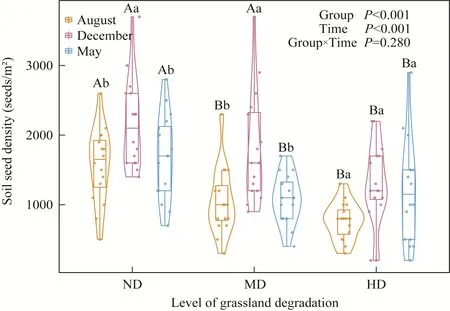
Fig.2 Soil seed bank density in 0-15 cm of soil in different months in non-degraded (ND), mildly degraded(MD), and heavily degraded (HD) grasslands.The contour out of the box represents the frequency of data.Different lowercase letters within the same month represent significant differences among different degradation levels at P<0.05 level.Different uppercase letters within the same degradation level represent significant differences among different months at P<0.05 level.

Fig.3 Percentage of functional groups of vegetation (a) and soil seed bank (b) in different months in non-degraded (ND), mildly degraded (MD), and heavily degraded (HD) grasslands
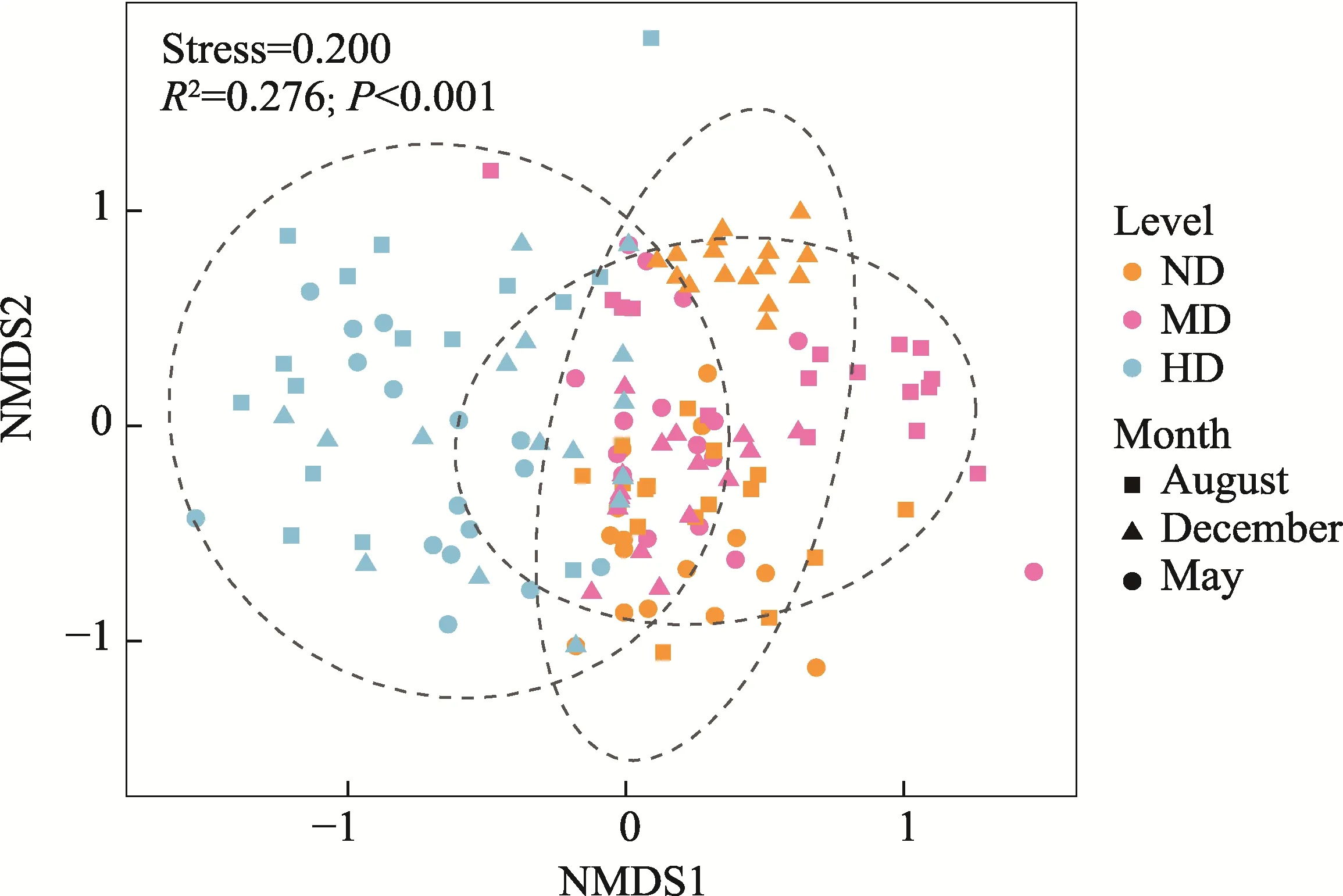
Fig.4 Two-dimensional nonmetric multidimensional scaling (NMDS) ordination of species composition of soil seed bank under different levels and months of grassland degradation
3.2 Above-ground vegetation and soil measurements
A total of 35 species, 15 families, and 29 genera of vegetation were surveyed, i.e., 24 species, 11 families, and 20 genera in ND; 18 species, 8 families, and 14 genera in MD; and 19 species, 9 families, and 19 genera in HD (Table 3).There were 4 common species across all degradation levels, 6 common species between ND and MD, 4 common species between MD and HD, and 8 common species between HD and ND (Fig.S1).Perennial species accounted for 82%-84% of all vegetation species.The largest families were Asteraceae and Fabaceae (6 species each), followed by Poaceae (3 species).E.nutans,P.pratensis, andK.macrantha(Poaceae) were the dominant species in ND;P.pratensisandK.macranthawere the dominant above-ground species in MD;whileAnaphalis lactealMaxim.andTaraxacum mongolicumHand.-Mazz.(Asteraceae) were the dominant species in HD (Table S1).

Table 3 Species composition of soil seed bank and above-ground vegetation
Proportion of grasses was greater in MD than in ND and HD, whereas, the proportions of forbs and legumes were greater in HD than in ND and MD (Fig.2).Above-ground biomasses were greater in ND (64.8 (±5.35) g/m2) and MD (47.67 (±9.53) g/m2) than in HD (5.23 (±4.32) g/m2)(Fig.S3;P<0.050), that is, above-ground biomass decreased with increasing degradation.Species richness, Shannon-Wiener, and Simpson diversity indices of vegetation were all greatest in ND followed by HD and MD (Fig.S4).The S?rensen index was 0.49 between ND and MD, 0.56 between ND and HD, and 0.39 between MD and HD (Table 2).Soil pH increased, whereas soil moisture, SOC, AN, AP, and TN decreased with an increase in the level of grassland degradation(Fig.S5;P<0.050).
3.3 Relationship between soil seed bank and vegetation
A total of 16 species were observed in both above-ground vegetation and soil seed bank (Kobresia capillifolia(Decne.) C.B.Clarke,K.macrantha,Artemisia frigidaWilld., andP.viviparawere dominant species), while only 3 species (K.filifolia,R.tanguticus, andAllium ramosumL.) were observed in soil seed bank in each sampling month (May, August, and December) (Fig.S1; Table S1).Similarity in species composition between vegetation and soil seed bank ranged from 0.15 to 0.69.Based on degradation level and sampling month, HD displayed the highest similarity index(0.43-0.69), followed by ND, and then by MD.Similarity index was greater in August (0.33-0.55)than in May and December, indicating that persistent seed bank was more similar to vegetation species than transient seed bank (Table 2).
4 Discussion
4.1 Effect of sampling month on soil seed bank
Sampling month, vegetation type, and level of grassland degradation affect temporal dynamics of soil seed bank (Chu et al., 2019; He et al., 2021).This study displayed differences in seed density across sampling months, with the greatest density in December after seed dispersal, which was followed by a slow decline.There is an increase in soil seed bank after seed maturation in the following year, while there is a decrease in soil seed bank due to animal consumption and fungal infections (Dalling et al., 2011).Sampling month had an impact on species richness, and the Shannon-Wiener and Simpson diversity indices of soil seed bank.The reasons for the effects of sampling month on those indices are as follows: (1) the study sites were grazed only in summer,and livestock consumes forage selectively and disperses seeds through epizoochory (wool) and endozoochory (dung) (Cosyns et al., 2005; Wang and Hou, 2021); (2) invertebrates, such as ants,and small mammals, such as rodents, transport and cache seeds, thereby affecting the species composition of soil seed bank (Zhao et al., 2020); and (3) physiological characteristics of seeds vary, i.e., some seeds germinate shortly after dispersal in autumn, some need to overwinter and germinate in the following spring, while some require even longer periods to germinate(Thompson and Grime, 1979).
In contrast to previous findings that transient seed bank density remains stable along degradation gradient (He et al., 2021), there was a decrease in transient seed bank density with an increase in degradation level in this study.The difference between results could be attributed to differences in vegetation types and dominant species.Soil seed bank density was the greatest in December followed by May and August, indicating that the density of transient seed bank was greater than that of persistent seed bank.Species composition across different sampling months displayed minimal change, suggesting that species compositions of transient and persistent seed banks remain relatively stable between years.
4.2 Effects of grassland degradation on above-ground vegetation and soil seed bank
Above-ground biomass decreased gradually with an increase in grassland degradation, probably due to a depletion in soil nutrients.This premise was supported by the decrease in soil SOC, TN,AN, and AP contents with an increase in soil degradation (Fig.S5).Plant species richness, and Shannon-Wiener and Simpson diversity indices were greater in HD than in MD, likely due to increased richness and abundance of forbs in HD, particularly Asteraceae (Saussurea alpina(L.)DC,A.lacteal, andT.mongolicum).Soil physical-chemical properties are not only related to the input of seeds, but also to seed survival in soils.Ma et al.(2017) reported soil seed bank density was negatively correlated with pH, but positively with soil organic matter and water content.Similar results emerged in this study.However, seed density, species richness, and Shannon-Wiener diversity index of soil seed bank were lesser in HD than in ND, indicating that grassland degradation had a detrimental impact on soil seed bank density and diversity.Seed density of annual species (E.nutans,K.macrantha, andPlantago depressaWilld.) varied significantly with grassland degradation, while perennial species (S.alpina,R.tanguticus, andK.filifolia) were not affected by grassland degradation.
Persistent seed bank density of over 200 seeds/m2at a depth of 10-15 cm in ND and MD in August indicated that seeds were at that depth due to animal activities, and that they could withstand soil surface disturbance (Shang et al., 2013).Transient seed bank density in HD at 10-15 cm soil depth in May accounted for 26.7% of total seed density, which was due to the dominance of forbs.Forbs have small seeds that minimize predation by being buried quickly(Gonzalez and Ghermandi, 2008).In this study, proportion of forbs in soil seed bank and vegetation increased with degradation, and it accounted for 0.55-0.68 of the total in HD (Fig.3).Two reasons could explain this occurrence: (1) forbs have competitive advantages in HD with low soil moisture and poor nutrients because forbs produce deep roots that utilize nutrients from deep soil depths (Shang et al., 2015); and (2) grazing livestock selects grasses that benefit the establishment and growth of forbs and, ultimately, leads to increased number of forb seeds (Zhang et al., 2020).For example,T.mongolicum,Stellera chamaejasmeL., andP.depressawere present only in HD.Forbs in HD may have provided a protective environment for sedges, enabling a certain percentage of sedges to thrive.The wide distribution of forbs in HD may have contributed to a reduced grazing pressure for surrounding plants by releasing an unpleasant scent that deters livestock (Zhang et al., 2020).
4.3 Relationship between above-ground vegetation and soil seed bank
Previous studies found the low similarity of species between vegetation and soil seed bank in alpine regions (Ma et al., 2010), and the similarity lessened with grassland degradation (He et al.,2021).Low similarity in this study indicated that degraded alpine meadow relied more on the colonization capacity of vegetation, rather than on soil seed bank.Low similarity could be explained by the following reasons.Firstly, seed yield was low.In this study, 5 annual species (P.pratensis,A.lactea,G.squarrosa,P.depressa, andSilene conoideaL.) and 30 perennial species were identified in vegetation, and, therefore, plant communities were dominated by perennial species.Dominant perennial species werePotentilla chinensisSer.andP.viviparaand they relied on sexual reproduction, thus contributing little to soil seed bank (Ma et al., 2010).In addition, the relatively short growing season and low air temperature on the Qinghai-Tibetan Plateau limited seed development, which led to a greater reliance on clonal regeneration than seedling recruitment (Jaganathan et al., 2015; Fernandez-Pascual et al., 2021).However, vegetation in HD was dominated by forbs, which had a low palatability for livestock.Most of the seeds produced by forbs, such asAster alpinusL.andA.lacteal, contributed to soil seed bank, and, therefore,resulted in high similarity of forb species between soil seed bank and vegetation in HD.Secondly,seed germination rate was low.Most alpine seeds have dormancy requirements (Jaganathan et al.,2015; Fernandez-Pascual et al., 2021), and air temperature and humidity changes in the greenhouse were not large enough for some dormant seeds to germinate in a short time.Seeds from Gentianaceae and Apiaceae undergo dormancy and require a long period of cold conditions before germination (Liu et al., 2011).This may be one of the reasons whyGentiana stramineaMaxim.andCicuta virosaL.were observed in soil seed bank.Some seeds in soil seed bank came into contact with Ascomycetes, which increased seed mortality and loss (Wagner and Mitschunas,2008).Therefore, direct germination methods may underestimate the density and diversity of soil seed bank, and, hence, underestimate the similarity between soil seed bank and vegetation.
Similarity between soil seed bank and vegetation was reported to be dependent on vegetation type, state, species composition, and succession history of vegetation (Shang et al., 2016).The greatest similarity of species between vegetation and soil seed bank was observed in August,suggesting that persistent seed bank plays a more important role in vegetation regeneration than transient seed bank.Seeds in persistent seed bank exhibit longevity in soil, and soil environment is more important for the storage of persistent than transient seed bank (He et al., 2021).Similarity of species between soil seed bank and vegetation across sampling months was greater in HD than in ND and MD, and, therefore, similarity increased with increasing degradation level,as reported by other studies (Luzuriaga et al., 2005; He et al., 2021).This result also demonstrated that contribution of soil seed bank to vegetation regeneration was greater in HD than in ND and MD.In addition, the greater similarity in HD indicated that HD lost its buffer capacity, while ND and MD retained some buffer capacity, which could be restored in degraded grassland by appropriate measures (Shang et al., 2016).The greater seed density of sedges and grasses in soil seed bank did not play an important role in vegetation regeneration of alpine grassland.Restoration of HD requires long-term grazing exclusion or introduction of seeds from local plant species due to the reduction of sedges and grasses (Shang et al., 2013).
5 Conclusions
Effects of grassland degradation on persistent and transient seed banks were determined by direct germination method in ND, MD, and HD grasslands.Grassland degradation reduced above-ground biomass and densities of persistent and transient seed bank, but did not affect species composition, diversity of vegetation, and soil seed bank.Sampling month had a significant effect on species richness and Shannon-Wiener and Simpson diversity indices of soil seed bank.Persistent seed bank was more important for vegetation regeneration and restoration of degraded grassland than transient seed bank, as there was a greater similarity in species composition between vegetation and persistent seed bank than transient seed bank.Similarity was greater in HD (0.43-0.69) than in ND and MD, indicating that HD lost its buffering capacity.We concluded that restoration of HD cannot rely solely on soil seed bank, and that other strategies,such as grazing exclusion and/or the introduction of local seeds, could be necessary.Species composition and ecological niche of vegetation and soil seed bank should be considered when selecting restoration methods.After restoration is completed, long-term monitoring and measurements on vegetation, soil, and soil seed bank should be continued.
Conflict of interest
The authors declare that they have no known competing financial interests or personal relationships that could have appeared to influence the work reported inn this paper.
Acknowledgements
This study was supported by the National Natural Science Foundation of China (31960279), the Science and Technology Program of Gansu Province, China (21JR11RA018), the Special Project for Central Universities to Build World-class Universities/Disciplines, and Characteristic Development Guidance, and Program for Changjiang Scholars and Innovative Research Team in University of Ministry of Education, China (IRT_17R88).
Author contributions
Conceptualization: LI Chunming; Data curation: MA Jiahui, LI Liangyu, HUANG Junlin, LU Jinhua;Methodology: LI Chunming; Formal analysis: HUANG Mei; Writing-original draft preparation: HUANG Mei, LI Chunming; Writing - review and editing: Allan DEGEN; SHANG Zhanhuan; Funding acquisition: LI Chunming.
Appendix
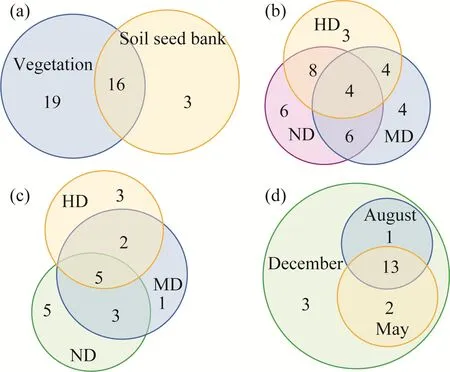
Fig.S1 Number of species in vegetation and soil seed bank (a); number of species in vegetation under different degradation levels (b); number of species in soil seed bank under different degradation levels (c); and number of species in vegetation under different sampling months (d).ND, non-degraded grassland; MD, mildly degraded grassland; HD, heavily degraded grassland.

Fig.S2 Soil seed density among different degradation levels and sampling months.(a), August; (b), December;(c), May.ND, non-degraded grassland; MD, mildly degraded grassland; HD, heavily degraded grassland.Different lowercase letters with the same degradation level indicate significant differences among different depths at P<0.05 level.Bars are standard errors.
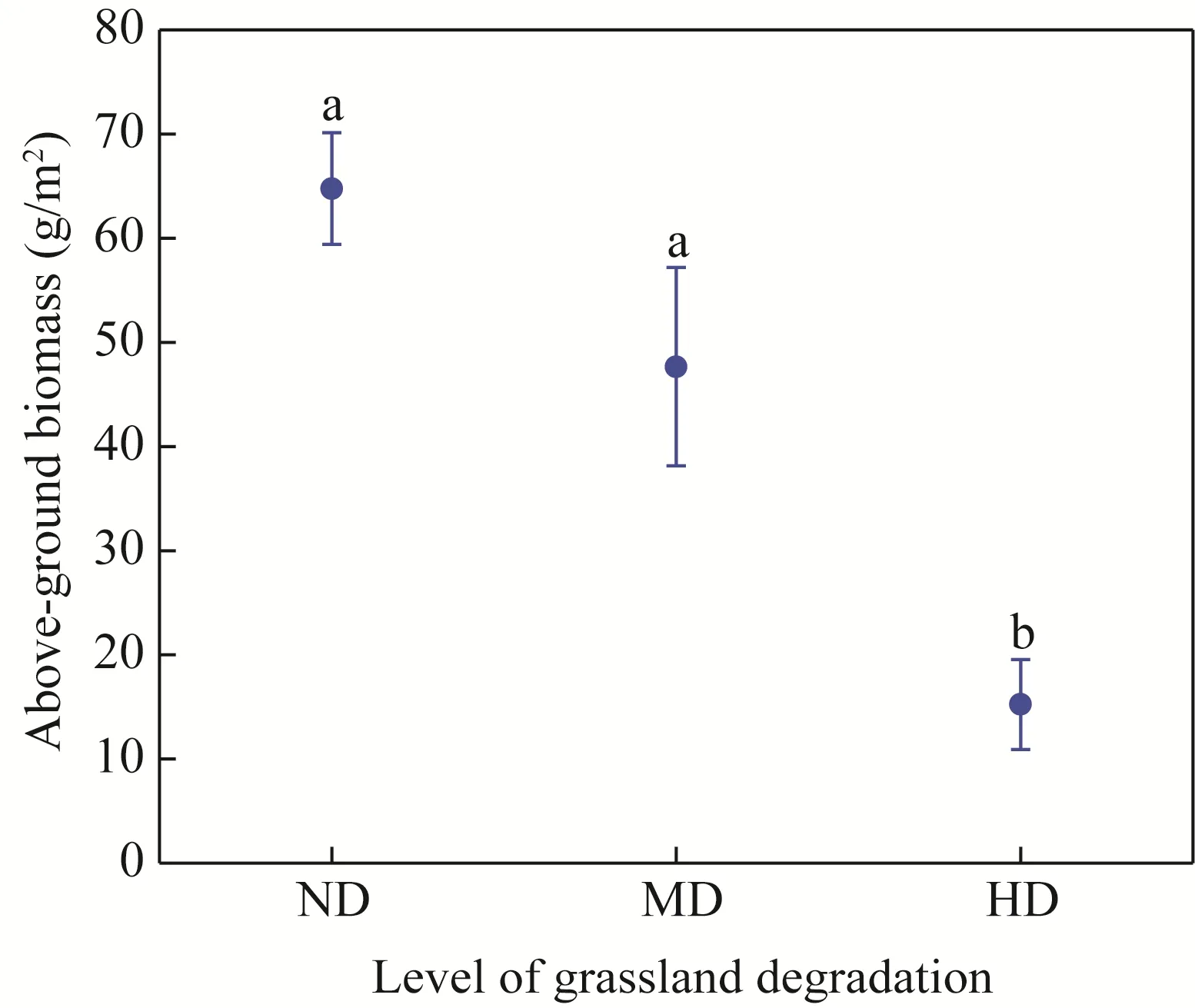
Fig.S3 Above-ground biomass under different degradation levels.ND, non-degraded grassland; MD, mildly degraded grassland; HD, heavily degraded grassland.Different lowercase letters indicate significant differences among different degradation levels at P<0.05 level.Bars are standard errors.
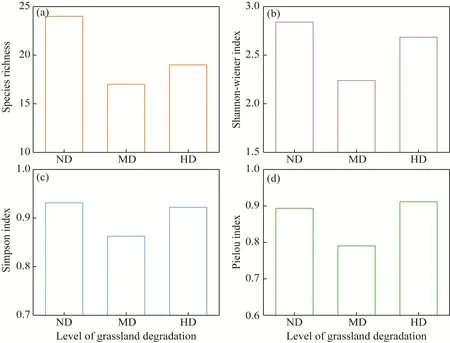
Fig.S4 Species richness (a), Shannon-Wiener (b), Simpson (c), and Pielou (d) diversity indices in vegetation in non-degraded (ND), mildly degraded (MD) and heavily degraded (HD) grasslands
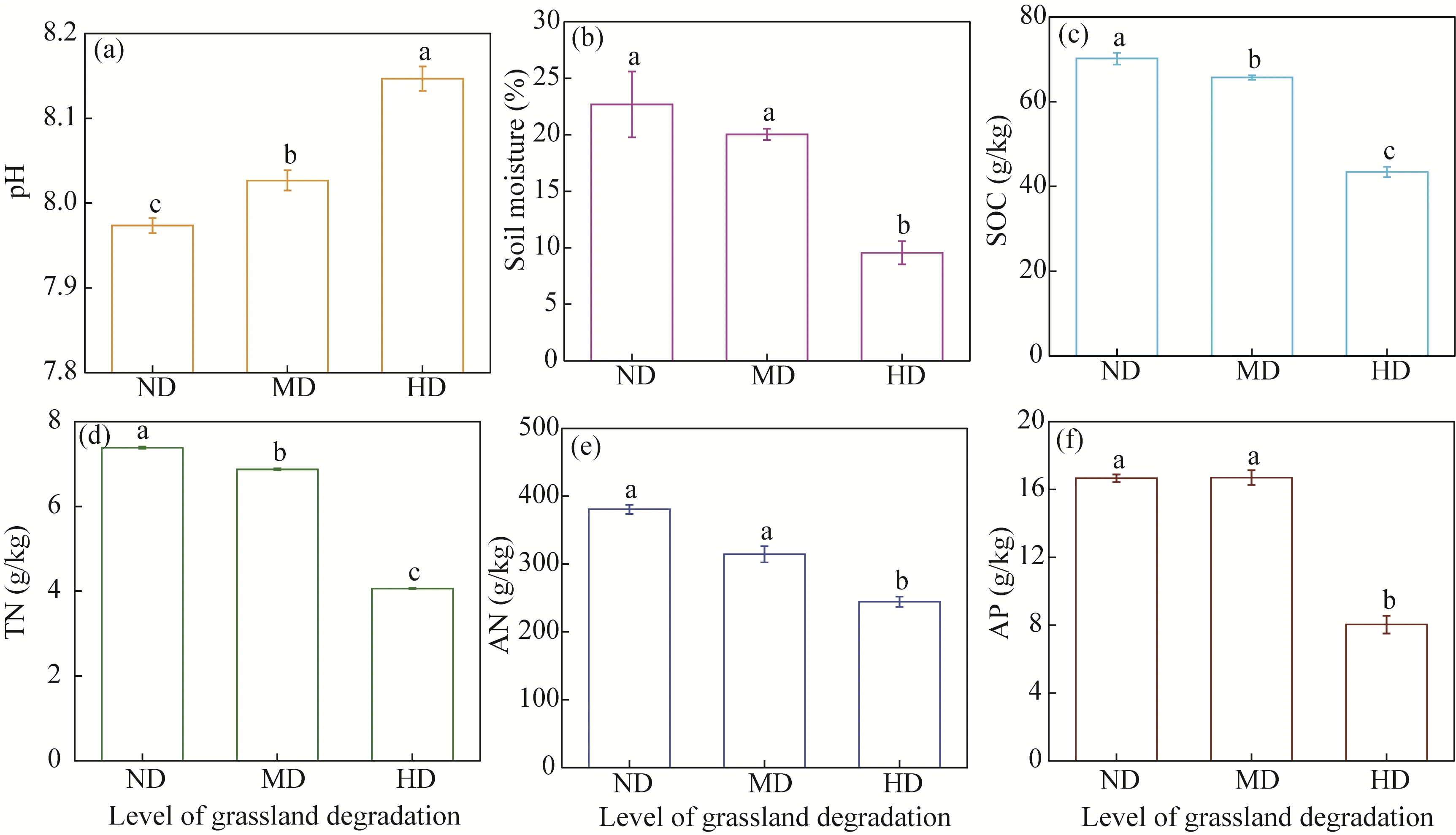
Fig.S5 pH (a), and contents of soil moisture (b), SOC (soil organic carbon; c), TN (total nitrogen; d), AN(available nitrogen; e), and AP (available phosphorus; f) under different levels of grassland degradation.ND,non-degraded grassland; MD, mildly degraded grassland; HD, heavily degraded grassland.Different lowercase letters indicate significance among different degradation levels at P<0.05 level.
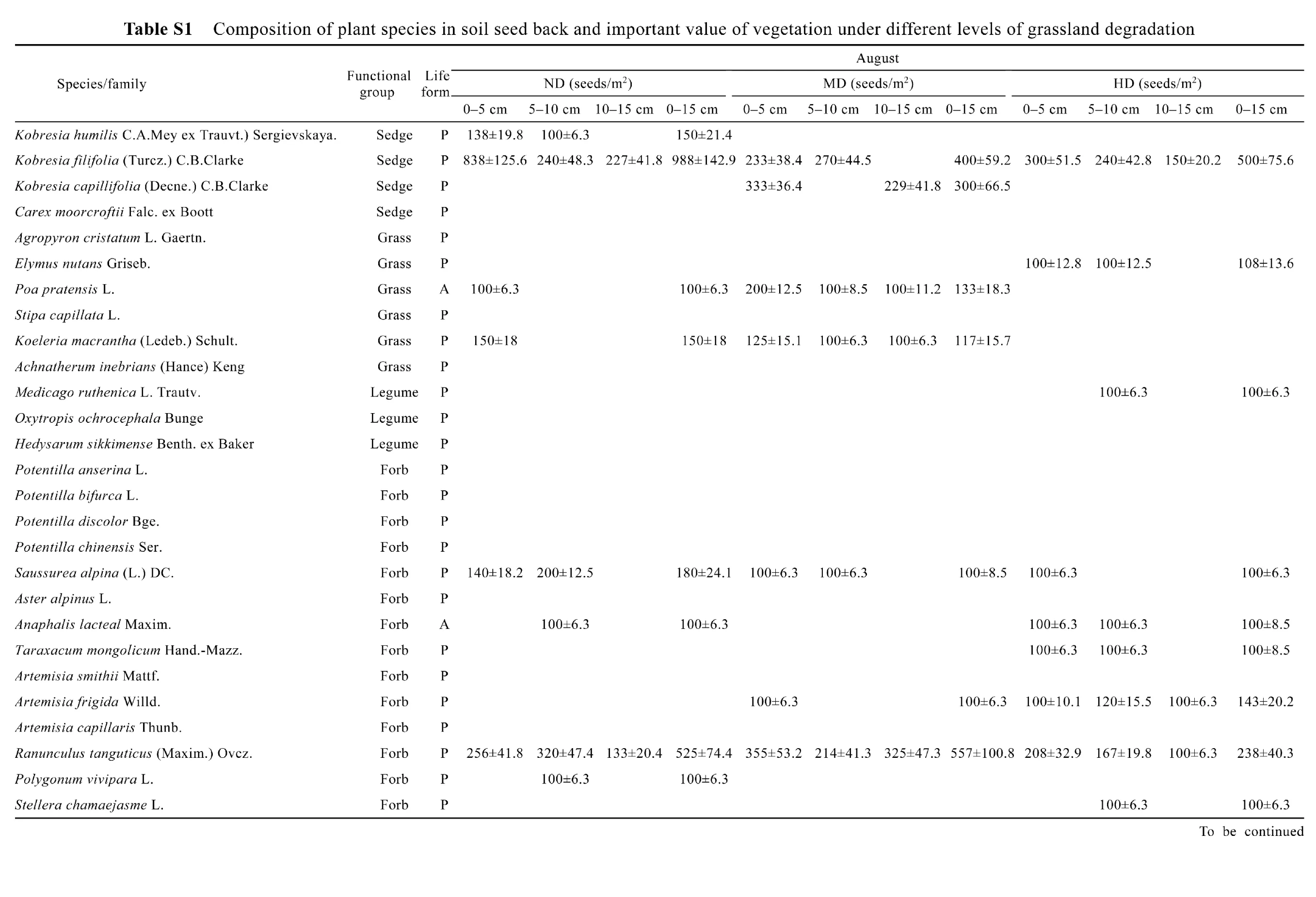
?
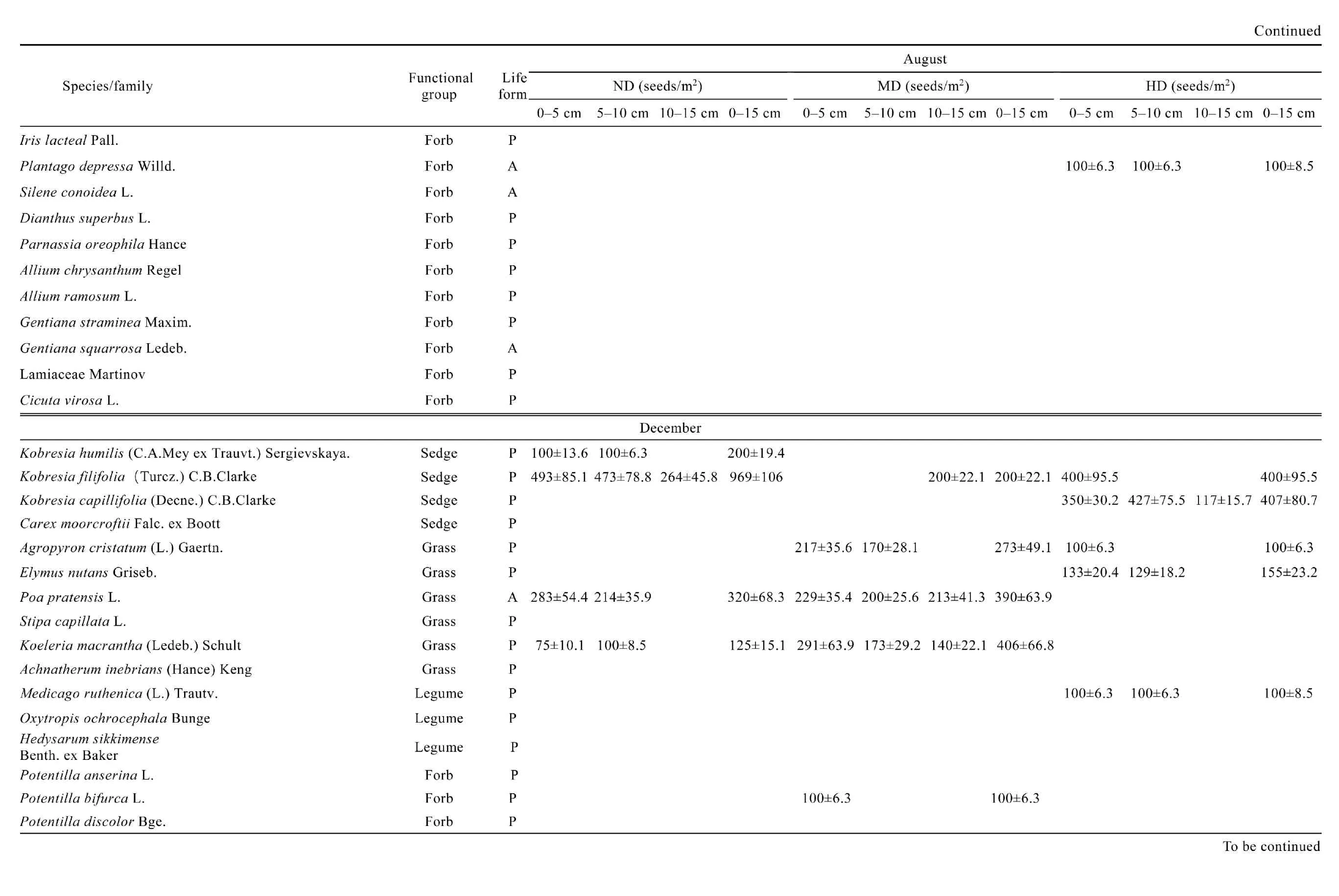
?
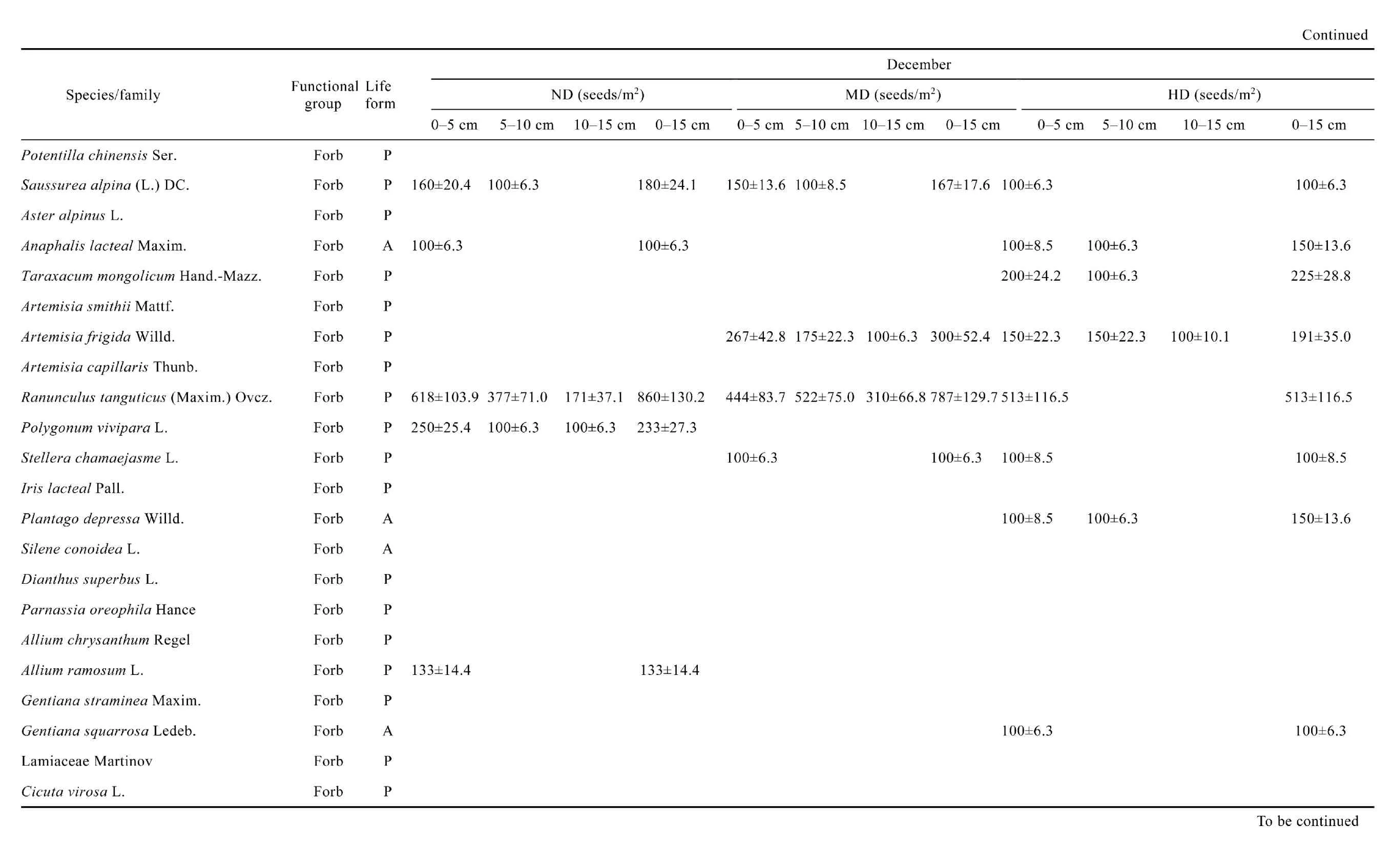
?
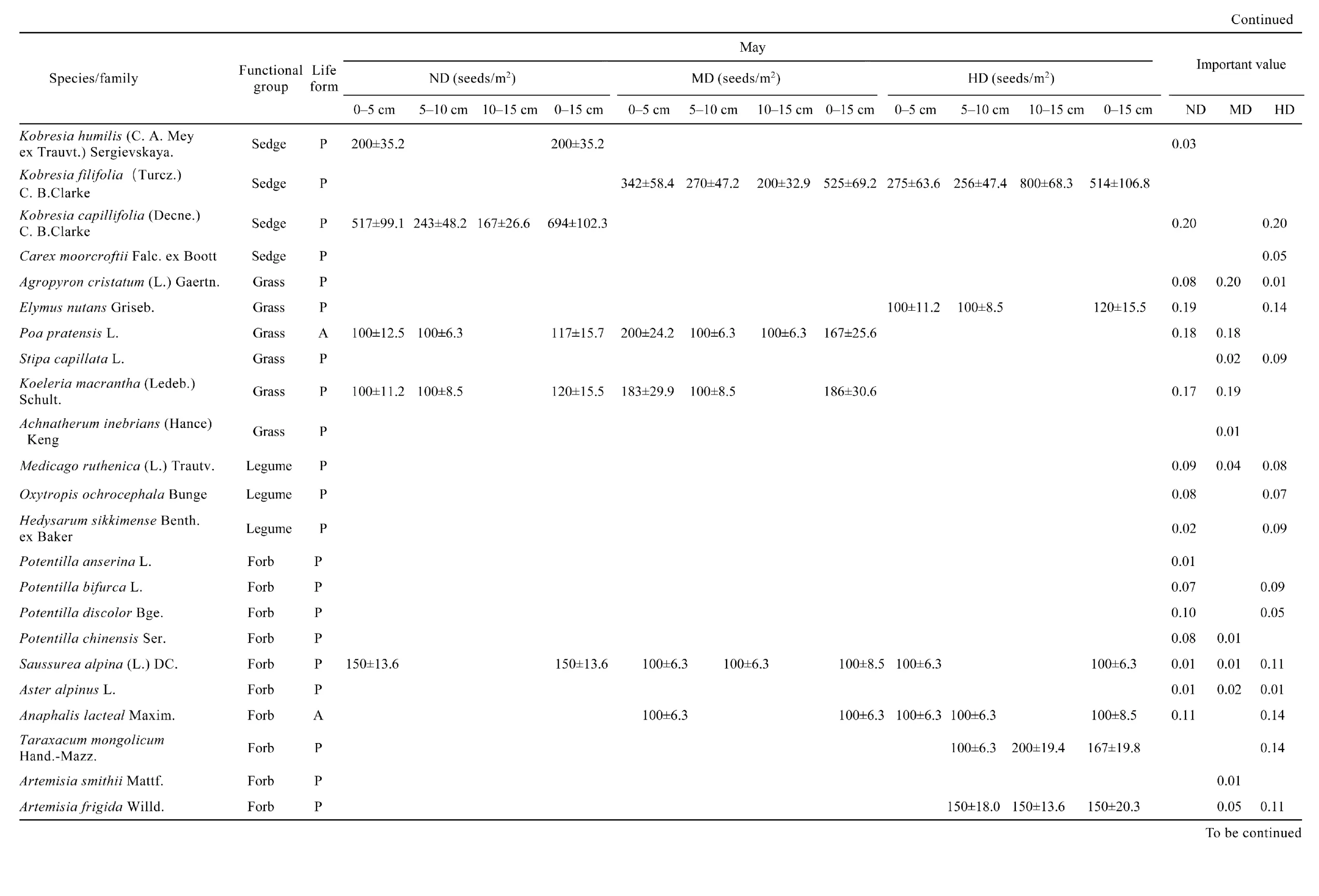
?
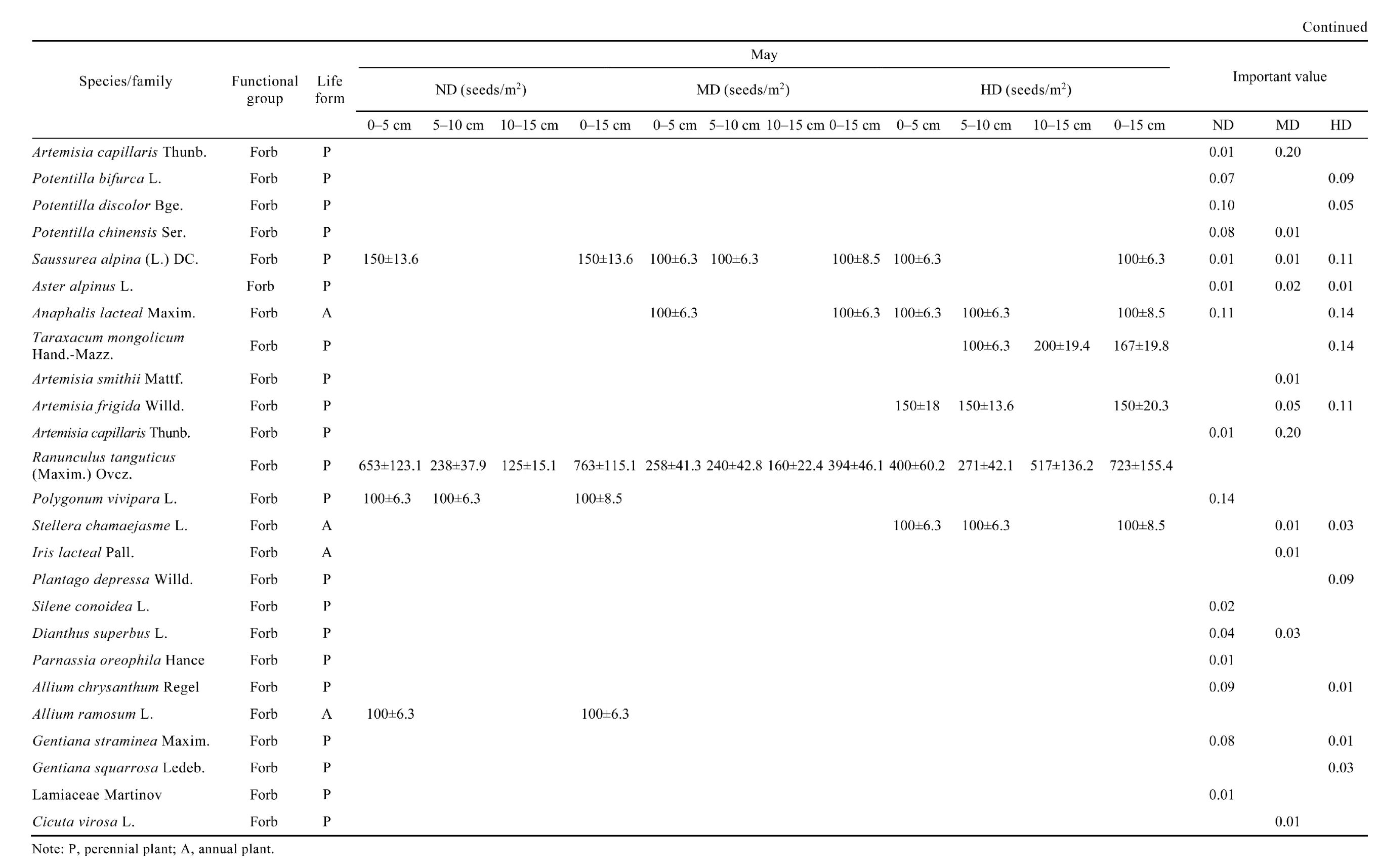
?
- Journal of Arid Land的其它文章
- Integrating stable isotopes and factor analysis to delineate the groundwater provenance and pollution sources in the northwestern part of the Amman-Al Zarqa Basin, Jordan
- Monitoring vegetation drought in the nine major river basins of China based on a new developed Vegetation Drought Condition Index
- Estimation and inter-comparison of infiltration models in the agricultural area of the Mitidja Plain,Algeria
- Evaluation of the water conservation function in the Ili River Delta of Central Asia based on the InVEST model
- Soil seed bank is affected by transferred soil thickness and properties in the reclaimed coal mine in the Qilian Mountains, China
- Analyzing environmental flow supply in the semi-arid area through integrating drought analysis and optimal operation of reservoir

